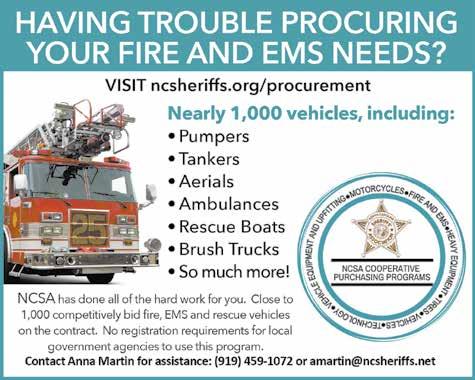
8 minute read
Focused Discipline for Your Retirement
News From the N.C. State Treasurer
Focused Discipline for Your Retirement
Advertisement
Are you doing enough to reach your retirement goals? In general, it is recommended you have 80 percent of your preretirement income in retirement to maintain the standard of living to which you are accustom. How can you need less income in retirement? There are several considerations, and it comes down to your expenses. By the time you retire, your home may be paid off, so you no longer have a mortgage payment. Child-related expenses and ongoing contributions to retirement savings will go down. Some people can do it with less, some people will have more, but we all will have a need for income in retirement.
Saving early and saving often will lead to better financial security, and a small amount can make a big difference. This simple strategy works because compound interest is applied to your initial savings and reinvested earnings. Your savings will accumulate as the years pass and when you reach retirement you will see that, as the saying goes, time is literally money.
If you are a member of the Local Governmental Employees’ Retirement System (LGERS), the same concept applies. You contribute six percent of your income to your pension each month and your employer, on average, contributes 14 percent on your behalf. This, combined with investment earnings — which reached 14 percent at the end of 2020 — provides the foundation for your potential lifetime pension benefit.
Not everyone starts early and continues working all the way through to retirement. Some people are not thinking about retirement in their 20s and 30s. Others may stop working to take care of children and families. In these cases, the other adage rings true — there is no time to lose. Starting later and filling in the gaps takes effort and dedication because you have lost the power of compounding incremental savings over a longer period. There are some things you can do: cut
expenses, start saving and save more. If you are working for an LGERS employer, you may be eligible to participate in the North Carolina Supplemental Plans (NC 401(k) and NC 457 Plans) (Plans). These are some of the largest and lowest cost plans of their type and these supplemental retirement Dale Folwell savings can help to increase your income. And, unlike some plans, you do not have to leave the plans when you leave your job. In fact, you can roll money in and remain in the plans up to and through retirement, continuing to reap the benefits of high performance, low cost and one-on-one counselor support. The plans have received over 15 awards for plan design, participant education and communication. This year the annual National Association of Government Defined Contribution Administrators (NAGDCA) Leadership Awards Program, designed to distinguish the brightest ideas and most innovative solutions from across the industry, recognized the Department of State Treasurer (DST), Board of Trustees (board) and staff with two Leadership awards for outstanding achievements in Technology and Interactive Multimedia and National Retirement Security Month awareness. Being recognized with two leadership awards in high-impact categories is a testament to the good work and collaborative relationship between the board and staff, and individual employers and participants. If you are volunteer firefighter who works full-time for a non-governmental employer, I would encourage you to participate in the retirement offerings at your workplace. No matter who your employer is, it is important to know and understand your retirement benefits including investment options, an employer match or additional contribution. While some firefighters and rescue squad workers are contributing members of LGERS, all firefighters and rescue squad workers who meet specific requirements and contribute $10 per month are members of the Firefighters’ and Rescue Squad Workers’ Pension Fund (FRSWPF).
Each of these benefit plans are governed by the LGERS Board of Trustees (LGERS Board) who actively serve with a member-first mentality. They work with DST staff to ensure the plans are working for the benefit of past, current and future members, including eligible firefighters and rescue squad workers.
By statute, there is a FRSWPF Advisory Panel (panel) that is responsible for considering the status and needs of the FRSWPF alone. There are times when this fund may diverge from the needs of other pension plans, requirements of state or federal law, or the policy goals of other stakeholders. Per statute, the panel consists of seven people, including: the Director of the Retirement Systems, a North Carolina Department of Insurance designee, one person representing the public at-large, and four paid and volunteer firefighters and rescue squad workers. In addition, one of the members of the panel must also serve on the LGERS Board.
DST supports, informs and provides advice to the panel. A Status and Needs Report for the Firefighters’ and Rescue Squad Workers’ Pension Fund is presented annually to the LGERS Board. In this report, the panel provides recommendations for funding and investment policies, administration and benefits and other items that may provide further efficiencies.
With the member-first mentality, the LGERS board, panel and staff at the Retirement Systems Division work together to find out what is right, get it right and keep it right on behalf of those that teach, protect and otherwise serve the citizens of North Carolina. The results of this effort have been significant and the FRSWPF has reached new heights in funded ratios. As of Dec. 31, 2019, the FRSWPF had approximately $459 million in assets and over 55,000 members, with an actuarial valuation placed the funded ratio at 92.3 percent — significantly higher than 83.7 percent just eight years ago.
Your pension is a part of your retirement income. But this typically must be combined with other savings and income sources, like Social Security. Your supplemental retirement savings (NC Plans) will help to build your retirement income to a level meets your expectations and where you want to be in retirement. If you can, I would encourage you to save early, save often and utilize your employer’s benefit offerings.
Thank you for your dedication and support to the communities and people in North Carolina.
The FRSWPF provides benefits to all eligible paid and volunteer certified firefighters and rescue squad workers. For more information about the FRSWPF, enrollment documents, monthly contributions, and applying for retirement, visit: https://www.myncretirement.com/nonretirees/fire-and-rescue-personnel
For more information about LGERS and the North Carolina Retirement Systems, visit: https://www.myncretirement.com/

Cont’d from page 17 rate, blood pressure and cerebral perfusion. This can take a minute or two where the victim feels the symptoms of presyncope, or it can be instantaneous as in a person fainting over the sight of blood or being stuck by a needle. A victim will never know how soon this event will occur, but it will be very rapid. Elements of the Suspension Trauma Cascade can present so suddenly that the suspended victim may have little opportunity to respond in an effective manner. One of the earliest symptoms of suspension trauma is cognitive impairment or confusion which makes the suspended victim much less likely to be able to assist in their own self rescue.
As soon as the Suspension Trauma Cascade progresses to the victim’s limits of physical or emotional tolerance, unconsciousness will occur by hypovolemic shock, vasovagal event or both. During unconsciousness, the respiratory rate will slow, oxygenation of the brain and heart will diminish, thus causing a greater drop in respiration and blood pressure which causes a further drop in oxygenation and the cascade spirals downward. There will be permanent brain damage in a few minutes. The heart will stop shortly after that when it sustains a global myocardial infarction, a “massive heart attack” from the lack of oxygen and death occurs. All of this can happen in “less than 30 minutes.” (Next issue will discuss more about the 10 victims from the Austrian report.)
Dr. Wood was a member of the West Virginia WV State Police in 1985 and became a Special Agent for the Organized Crime Drug Enforcement Task Force, US Customs Service, San Francisco, CA. He later attended the West Virginia School of Osteopathic Medicine, after 16 years in law enforcement. He graduated with honors. In 1998 during his residency training, he fell 20 feet out of a tree while trimming a limb. He was not wearing a fall arrest harness.
Dr. Wood had to drag himself 100 yards, crawl onto his 4-wheeler and drive to his cabin to call for help. He was transported to the Trauma Center where he worked and was placed in the Intensive Care Unit for the first week. He broke his pelvis in two places, left hand and had internal bleeding. As Dr. Wood states, “when you cannot walk for almost four months it gives you a lot of time to think”.
During his recovery and up to the present time, Dr. Wood has been working on safety products that make elevated work and treestand hunting safer. He has been awarded four U.S. Patents for fall safety equipment and is the owner of several U. S. Patent Pendings.
In 2010, Dr. Wood finished his long term project, The Rescue One CDS (Controlled Descent System) harness, a new revolutionary full body safety harness that eliminates serious injury or death from suspension trauma.
Dr. Wood is currently the lead physician for Kittitas Valley Healthcare Medical Clinic, Cle Elum WA.

Rear-attached safety harness leg straps exert direct compression of the femoral vein.












